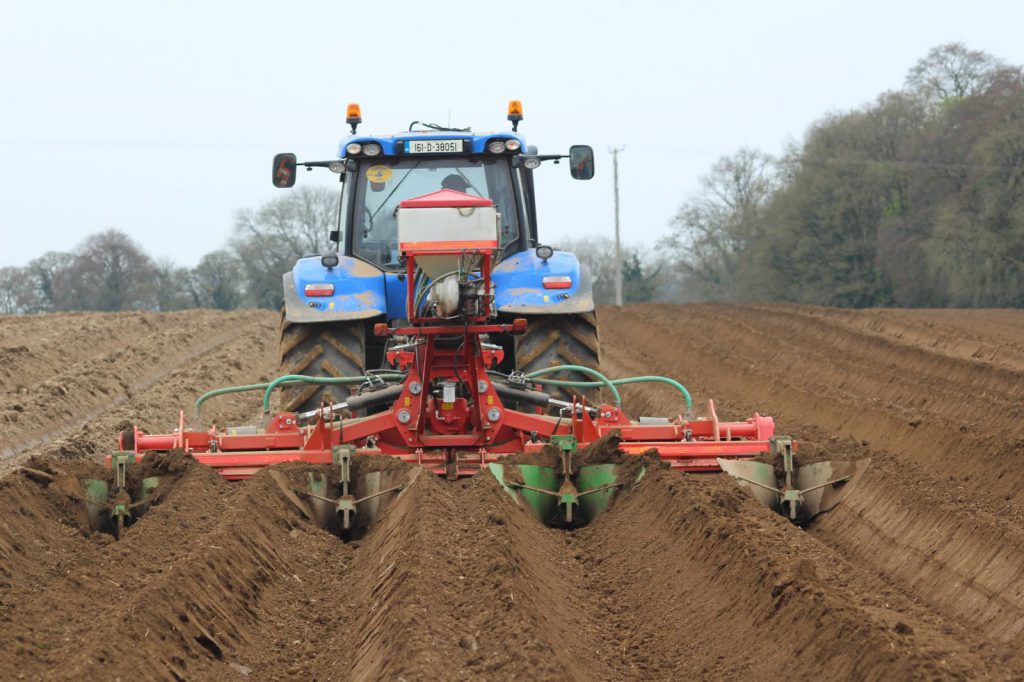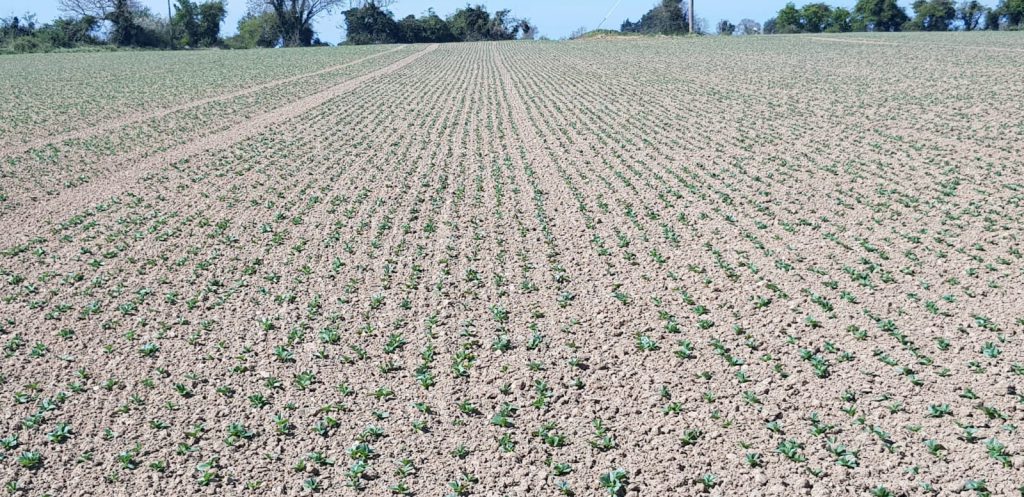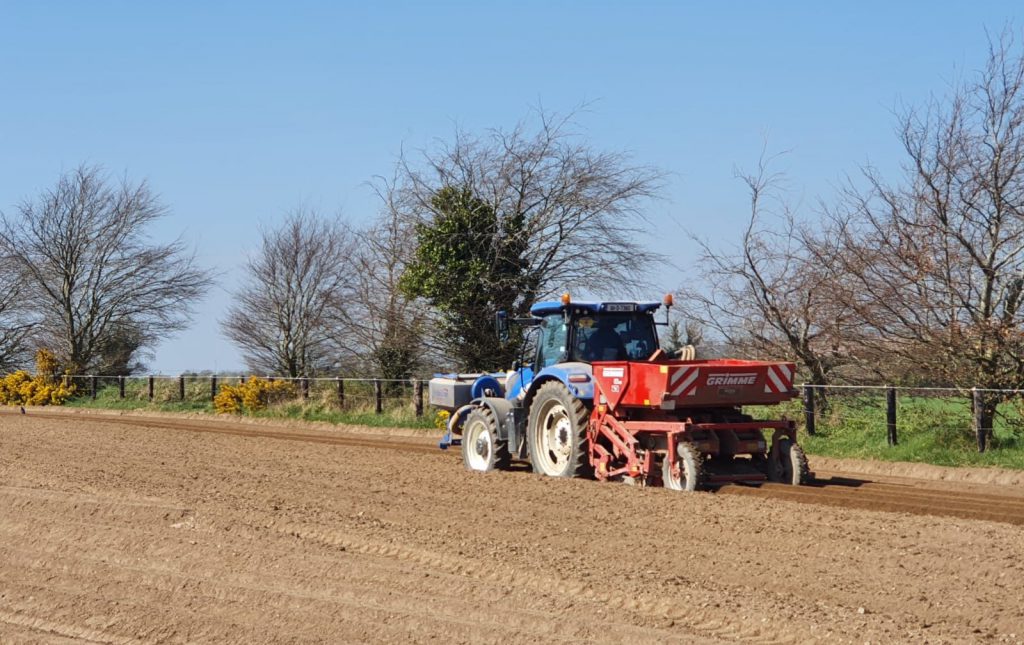It’s the wheat that’s being irrigated on Whyte Brothers’ Farm these days; not the potatoes. Rain is needed in the north-east where the farm spans across almost 3,000ac in counties Meath, Dublin and Louth.
When talking to AgriLand this week, Ollie Whyte was out walking crops. He pulled in to take the call at Annagassan, Co. Louth, where spring barley was starting to peep above ground.
The Whyte Family farm is unique. Seven brothers farm together with seven of their sons. Well-known for their potatoes, the brothers also have a large beef-finishing operation. Those animals are fed a completely Irish ration – the majority of which is produced on Whyte’s farm.
Asked about the current season, Ollie explained: “We’d normally have all winter crops. Last year we had 7ac of spring barley and we had maize. This year is a complete reverse,” Ollie explained.
Less than 40% of the usual winter cereal area was planted on the farm. The focus was to plant winter wheat which is now looking well for the most part according to Ollie. However, winter wheat crops planted in January and February are “struggling to get going”.
Irrigating winter wheat
Interestingly, Ollie noted that they are irrigating the late-sown wheat. “The ground dried and is now rock hard. There’s no vigour in the plant.
We either had to take it out or do something; so we’re irrigating.
Ollie explained that a river runs through the farm so the easy access to water made this a possibility. An umbilical system is being used to apply 10mm of water over two days. Another 10mm might be applied a few days later. Liquid nitrogen in the following days may also help to boost the crop.
Up-to-date on management
All winter cereals have received their main split of nitrogen and spraying is up to date.
“Everything is up to date. The early sown winter wheat received a T0 at the start of last week. The T1 will go on at the end of next week. The T1 will probably be Bravo and Ascra, with CeCeCe.”
He added that there was a touch of rust in the winter wheat and so a strobilurin was added at T0.
“The winter barley got a fungicide and growth regulator and it’s looking very well. I’m very optimistic about that. The winter oats received Ceraide, Talius and a weed spray.”
Spring sowing
Ollie worked on the seed drill this spring. He noted that everyone stuck to the one tractor this season due to the risk of Covid-19. Hand sanitiser and disinfectant is also in high supply to ensure everyone keeps safe.
He stressed the importance of everyone following guidelines to limit the spread of the virus, adding that he has huge admiration for the frontline workers and is proud of the members of his family working on that frontline.
I put in 130ac of beans. We haven’t grown beans in a few years because it’s a late harvest, it doesn’t suit us when we’re digging potatoes and sowing.
“They’re an absolutely lovely crop. We put in two varieties – Lynx and Tiffany. My thinking on this was to try and get back into winter wheat.

Ollie Whyte filling the seed drill wearing a mask which is blowing fresh air at his face and is keeping the dust away
“We always grow a lot of oats for Drummonds so we put in 600ac of spring oats [Husky and Isabel] with a view to that going into winter wheat next season.”
Ollie noted that Whytes have been growing oats for Drummonds for 40 years.
You can’t really grow oats unless you have an outlet for them.
KWS Chilham was the spring wheat variety sown on the farm. 190ac were planted. On this, Ollie commented that that was all the seed they could get, a sign of the demand for spring seed this season.
Sowing was completed on April 11, having first started sowing beans on March 19. Spring barley – Gangway and Errigal – was the last crop to be planted and 80% of that crop was up when talking to Ollie on Tuesday.
Potato planting finished up in early April and most are destined for Country Crest, with some going to Dennigans.
“We started shortly after St. Patrick’s Day and we got a very clean run through it. Every year we put about 35ac of ley into the rotation.”
Feeding cattle from their own farm
The Whytes have a large finishing operation on their farm. These continental heifers and bulls are fed from feed which is almost entirely produced on the farm with the exception of beans which are bought in from Drummonds and come from local farms.
Ollie noted that optimum fat scores seem to be easier to achieve on this ration compared to other farms which may be relying on a ration which is most likely high in imported grain such as maize.
He added that bulls which went to the factory last week were born in mid-January 2019 and once they entered the shed to be finished they gained almost 2kg/head/day.
‘The native grains should be at the heart of Origin Green’
When speaking about the home-grown ration Ollie is clearly very proud. It’s something that he’s passionate about and he grows frustrated as he continues to talk about it.
He sees major problems with the current system operating in this country where large amounts of grain are imported from countries which don’t produce grain to the same standards as Irish tillage farmers.
The native grains should be at the heart of Origin Green. What’s not to like with low carbon emissions and the way they’re produced?
“The chemicals used are all fully approved by Europe and everyone tells us it’s the safest grain in the world.”
Ollie cannot understand how GM feed and feed produced using chemicals no longer allowed here are being imported, as well as importing from areas where rainforests are being cut down.
He added that the new Common Agricultural Policy (CAP) and EU regulations will see nitrogen and chemical use decline further and that at the moment if tillage farmers don’t have their record in line or haven’t adhered to a buffer zone they will be penalised under cross compliance. In the mean time the boats float in from countries with a lot less restrictions.
He described the continuing importation of these products as “demoralising”.
“In 1980 I got more for my grain than I did last year. Our costs have multiplied by 10. That’s all very difficult.”
Ollie added that tillage farmers need to keep knocking on doors to promote the traceability of their grain. This in turn will lead to fully traceable Irish food.
Forward selling grain
The Whytes dry their grain using a biomass boiler which at present is burning miscanthus.
“Over the years when oil is at a normal price there’s a massive saving with it,” Ollie added.
I spend a lot of time on selling. For the past 15 years we have been forward selling. Most years we’re successful at it. The only time you lose is if grain goes to a mad high price in the harvest.
“At the same time you make a decision to sell when it’s leaving you money and we just go with small bits at a time. We do it bit by bit and it has worked out very well for us over the years. It lets us schedule finances and cash-flow. We do the same with potatoes.”
Straw merchants
The Whytes also bale about 5,000-6,000ac of straw per year for mushroom compost and the feed market. We load out about 12 lorry loads of straw every week of the year.
“With the 14 families that live on the farm, all full-time, you have to have a number of things going,” Ollie added.





